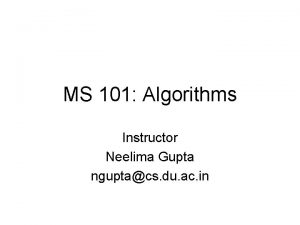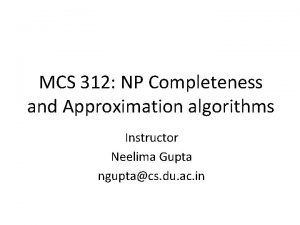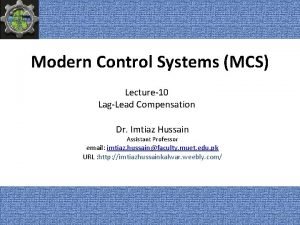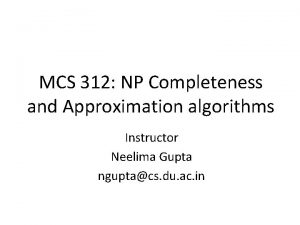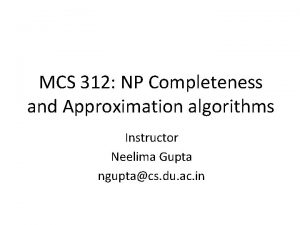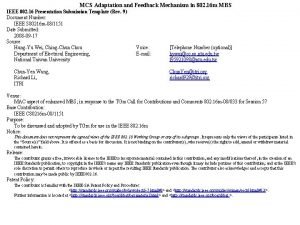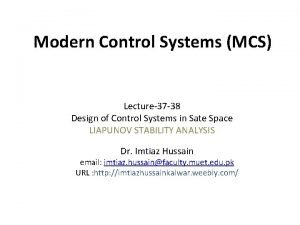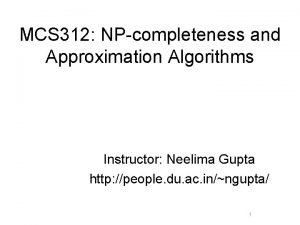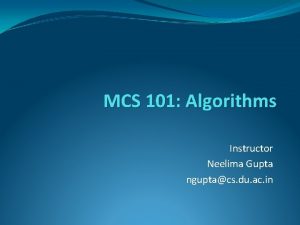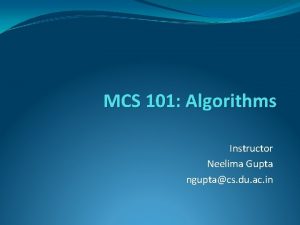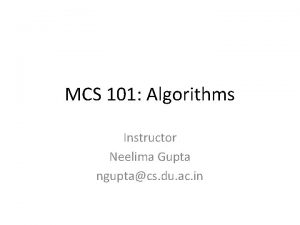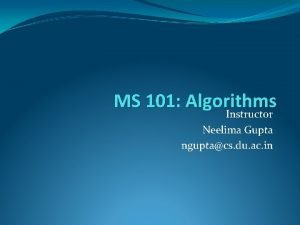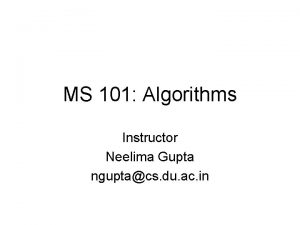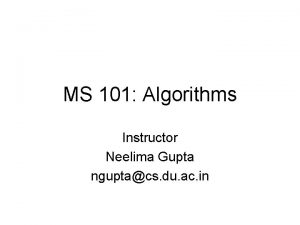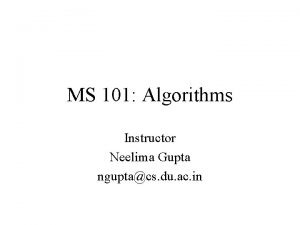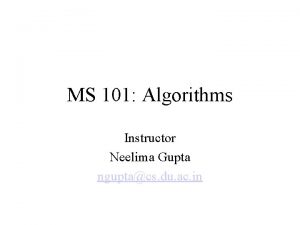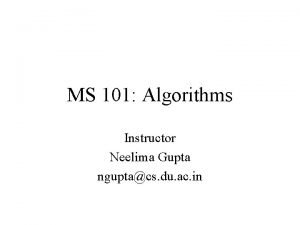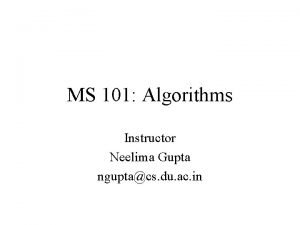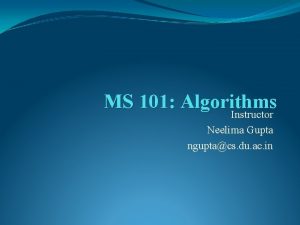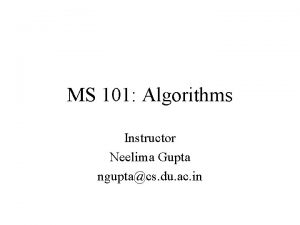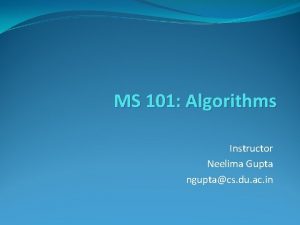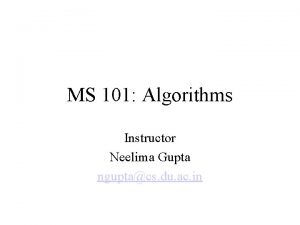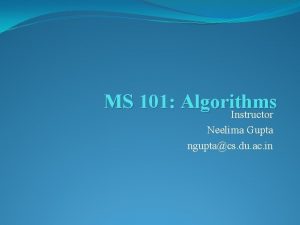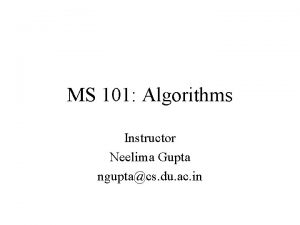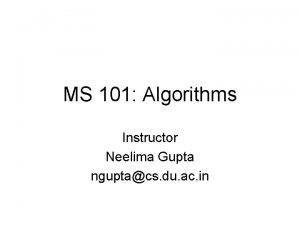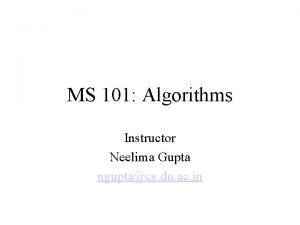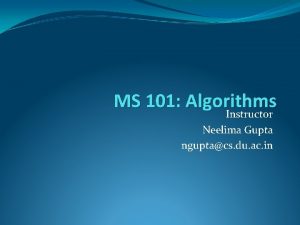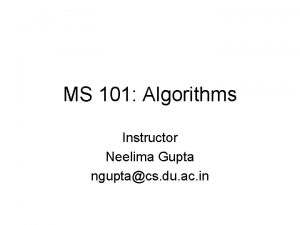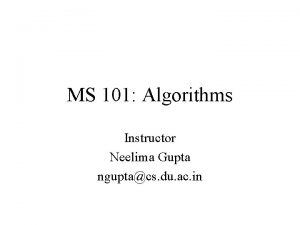MCS 101 Algorithms Instructor Neelima Gupta nguptacs du


![Pattern Matching • Given a text string T[0. . n-1] and a pattern P[0. Pattern Matching • Given a text string T[0. . n-1] and a pattern P[0.](https://slidetodoc.com/presentation_image_h2/6155a1563cd5f100f3bf8750b9cf9158/image-3.jpg)

































![EXAMPLE P: abcabcabcaf for k=1, fai[k]=0 (assumed) for k=2, s=fail[1]=0 therefore, fail[k]=0+1=1 for k=3, EXAMPLE P: abcabcabcaf for k=1, fai[k]=0 (assumed) for k=2, s=fail[1]=0 therefore, fail[k]=0+1=1 for k=3,](https://slidetodoc.com/presentation_image_h2/6155a1563cd5f100f3bf8750b9cf9158/image-37.jpg)
![P: abcabcabcaf for k=4, s=fail[3]=1 check whether p 1=p 3 since p 1!=p 3 P: abcabcabcaf for k=4, s=fail[3]=1 check whether p 1=p 3 since p 1!=p 3](https://slidetodoc.com/presentation_image_h2/6155a1563cd5f100f3bf8750b9cf9158/image-38.jpg)
![k 1 2 3 4 5 6 7 8 9 10 11 fail[k] 0 k 1 2 3 4 5 6 7 8 9 10 11 fail[k] 0](https://slidetodoc.com/presentation_image_h2/6155a1563cd5f100f3bf8750b9cf9158/image-39.jpg)
![k Fail[k] 1 0 2 1 3 1 P: abcabcabcaf 4 1 5 2 k Fail[k] 1 0 2 1 3 1 P: abcabcabcaf 4 1 5 2](https://slidetodoc.com/presentation_image_h2/6155a1563cd5f100f3bf8750b9cf9158/image-40.jpg)

![Another Example : k Fail[k] T: abcbabcabcabcaf 1 0 2 1 3 1 4 Another Example : k Fail[k] T: abcbabcabcabcaf 1 0 2 1 3 1 4](https://slidetodoc.com/presentation_image_h2/6155a1563cd5f100f3bf8750b9cf9158/image-42.jpg)
![Another Example : k Fail[k] T: abcbabcabcabcaf 1 0 2 1 3 1 4 Another Example : k Fail[k] T: abcbabcabcabcaf 1 0 2 1 3 1 4](https://slidetodoc.com/presentation_image_h2/6155a1563cd5f100f3bf8750b9cf9158/image-43.jpg)
![Another Example : k Fail[k] T: abcbabcabcabcaf 1 0 2 1 3 1 4 Another Example : k Fail[k] T: abcbabcabcabcaf 1 0 2 1 3 1 4](https://slidetodoc.com/presentation_image_h2/6155a1563cd5f100f3bf8750b9cf9158/image-44.jpg)
![Another Example : k Fail[k] T: abcbabcabcabcaf 1 0 2 1 3 1 4 Another Example : k Fail[k] T: abcbabcabcabcaf 1 0 2 1 3 1 4](https://slidetodoc.com/presentation_image_h2/6155a1563cd5f100f3bf8750b9cf9158/image-45.jpg)
![Another Example : k Fail[k] T: abcbabcabcabcaf 1 0 2 1 3 1 4 Another Example : k Fail[k] T: abcbabcabcabcaf 1 0 2 1 3 1 4](https://slidetodoc.com/presentation_image_h2/6155a1563cd5f100f3bf8750b9cf9158/image-46.jpg)



- Slides: 49

MCS 101: Algorithms Instructor Neelima Gupta ngupta@cs. du. ac. in

Table of Contents • String Matching – Naïve Method – Finite Automata Approach – Rabin Karp – KMP
![Pattern Matching Given a text string T0 n1 and a pattern P0 Pattern Matching • Given a text string T[0. . n-1] and a pattern P[0.](https://slidetodoc.com/presentation_image_h2/6155a1563cd5f100f3bf8750b9cf9158/image-3.jpg)
Pattern Matching • Given a text string T[0. . n-1] and a pattern P[0. . m-1], find all occurrences of the pattern within the text. • Example: T = ababcabdabcaabc and P = abc, the occurrences are: – first occurrence starts at T[3] – second occurrence starts at T[9] – third occurrence starts at T[13]

Let Σ denotes the set of alphabet. • Given: A string of alphabets T[1. . n] of size “n” and a pattern P[1. . m] of size “m” where, m<<<n. • To Find: Whether the pattern P occurs in text T or not. If it does, then give the first occurrence of P in T. The alphabets of both T and P are drawn from finite set Σ.

NAÏVE APPROACH T: P: a a b b c d a b d a a b c d e

Example T: P: a b c a b d a b ( Step – 1 ) d a a b Mismatch after 3 Comparisons c d e

Example ( Step – 2 ) T: P: a b c a b d a a b d Mismatch after 1 Comparison c d e

Example ( Step – 3 ) T: P: a b c a b d d a a b Mismatch after 1 Comparison c d e

Example ( Step – 4 ) T: P: a b c a b d a a b c Match found after 3 Comparisons Thus, after 8 comparisons the substring P is found in T. d e

Worst Case Running Time T : a a a……. . a a f of size say “n” P : a a a f of size 4

Example ( Step – 1 ) T: a P: a a a . . . a a f Mismatch found after 4 comparisons f

Example ( Step – 2 ) T: P: a a a a , , a a f Mismatch found after 4 comparisons f

Example T: P: a a a . . a a a Match found after 4 comparisons a a a f f

Worst Case Running Time This will continue to happen until (n-4)th alphabet in T is compared with the characters in P and thus the no. of comparisons required is (n-4)4 + 4.

Worst Case Running Time • At every step, after ‘m’ comparisons a mismatch will be found. • These ‘m’ comparisons will be done for m) characters in T. (n- • Thus, the running time obtained is (n-m)m + m.

Finite Automata #a ∑ #a a s 1 s 0 #a a s 2 a s 3 f f

Worst Case Running Time • In finite automata, each character is scanned atmost once. Thus in the worst case, the searching time is O(n). • Preprocessing time: - As for every character in ∑ an edge has to be formed, thus the preprocessing time is O(m*|∑|). • Thus total running time is O(n) + O(m*|∑|).

Drawback: If the alphabet set ∑ is very large, then the time required to construct the FA will be very large.

BRUTE FORCE STRATEGY • In this strategy whenever a mismatch was found , the pattern was shifted right by 1 character. • But this wasn’t an efficient strategy as it required a large number of comparisons. Hence a better algorithm was required. 19

An example T: abcabcaf mismatch found P: abcabcabcaf 20

Shift by 3 T: abcabcaf match found P: abcabcabcaf 21

Another example T: abcdeghabf mismatch found P: abcdeghabf 22

Shift by 7 T: abcdeghabf P: abcdeghabf 23

• How to decide how much to shift? • Ans: We use the information contained in the partial pattern that has matched so far.

KMP : Knuth Morris Pratt Algorithm T : …… tj. . …. . . tj+r-1 …. tj+k-r…. . . tj+k-2 tj+k-1 … ……………… P: p 1 …… pr …… ……… pk-1 pk …… p 1 …… pr pk … If tj+k-1 ≠ pk How much should we shift is equivalent to asking which character of the pattern, tj+k-1 be compared with? Thus we look for a prefix p 1 … pr of p 1 … pk-1 that matches the suffix of tj … tj+k-2, then , tj+k-1 should be compared with pr+1. 25

Several such prefixes may exist T: abcabcaf mismatch found P: abcabcabcaf One prefix is : a b c a ( r = 7) And Another is : a b c a ( r = 4) t 11 be compared with p 8 or p 5? Choose the longest prefix. . i. e largest such r. 26

KMP Contd. . • Let r be the length of the longest prefix of P that matches with the matched part of P. Then the pattern can be shifted by r positions instead of 1 and tj+k-1 should be compared with pr+1. • Claim 1: We have not missed any match i. e. the pattern does not exist at any position from j to j+k-r 1. • Proof: Had it been, we would have a longer prefix matching with its suffix.

Why LONGEST? T: abcabcaf mismatch found P: abcabcabcaf 28

T: abcabcaf mismatch found P: abcabcabcaf the longest prefix. Correct alignment for the pattern will be by shifting it 3 characters right. 29

T: abcabcaf P: abcabcabcaf Pattern found. 30

T: abcabcaf P: mismatch abcabcabcaf Pattern not found. By finding a smaller prefix and aligning the pattern accordingly as shown, the pattern’s occurrence in the text got missed (that is we shifted by more positions than we should 31

How to find the longest such prefix? KMP algorithm 32

KMP : Knuth Morris Pratt Algorithm T : …… tj. . …. . . tj+r-1 …. tj+k-r…. . . tj+k-2 tj+k-1 … ……………… P: p 1 …… pr …… ……… pk-1 pk …… p 1 …… pr pk … If tj+k-1 ≠ pk Since tj … tj+k-1 has already been matched with p 1 … pk-1 , we need to look for longest prefix p 1 … pr (r < k-1) of p 1 … pk-1 that matches with its own suffix. Thus the longest prefix can be found from the pattern itself and we do not need the text for the purpose……Note 1. 33

P : p 1 …. …………… pk ………… Let the length of the longest prefix of p 1 … pk-1 that matches its suffix be ‘r. ’ 34

T : …… tj. . …. . . tj+r-1 …. tj+k-r…. . . tj+k-2 tj+k-1 … ……………… P: p 1 …… pr …… ……… pk-1 pk …… p 1 …… pr pk … If tj+k-1 ≠ pk Let Fail[k] be a pointer which says that if a mismatch occurs for pk then what is the character in P that should come in place of pk by shifting P accordingly. Fail[k] is nothing but the length of the longest prefix plus 1. Thus the Q is How to compute Fail[k]? 35

P : p 1 … pr-1 pr pr+1 ……. …. pk-1 pk … p 1 … pr’-1 pr’+1 p 1…. . ps-1 ps ps+1 Look at fail[k-1]. Let it be r’. If pr’ = pk-1 (which has already been matched with tj+k-1) fail[k] = r’+1 1 else { look at fail[r’] = s , say if s>0 { if ps = pk-1 then fail[k] = s+1 else goto 1 with r’ = s } } else (i. e s = 0) fail[k] =1 36
![EXAMPLE P abcabcabcaf for k1 faik0 assumed for k2 sfail10 therefore failk011 for k3 EXAMPLE P: abcabcabcaf for k=1, fai[k]=0 (assumed) for k=2, s=fail[1]=0 therefore, fail[k]=0+1=1 for k=3,](https://slidetodoc.com/presentation_image_h2/6155a1563cd5f100f3bf8750b9cf9158/image-37.jpg)
EXAMPLE P: abcabcabcaf for k=1, fai[k]=0 (assumed) for k=2, s=fail[1]=0 therefore, fail[k]=0+1=1 for k=3, s=fail[2]=1 check whether p 2=p 1 since p 2!=p 1 so, s=fail[1]=0 therefore, fail[k]=0+1=1
![P abcabcabcaf for k4 sfail31 check whether p 1p 3 since p 1p 3 P: abcabcabcaf for k=4, s=fail[3]=1 check whether p 1=p 3 since p 1!=p 3](https://slidetodoc.com/presentation_image_h2/6155a1563cd5f100f3bf8750b9cf9158/image-38.jpg)
P: abcabcabcaf for k=4, s=fail[3]=1 check whether p 1=p 3 since p 1!=p 3 so, s=fail[1]=0 therefore, fail[k]=0+1=1 For k=5 s=fail[4]=1 check whether p 1=p 4 yes therefore, fail[k]=1+1=2 Similarly, for others.
![k 1 2 3 4 5 6 7 8 9 10 11 failk 0 k 1 2 3 4 5 6 7 8 9 10 11 fail[k] 0](https://slidetodoc.com/presentation_image_h2/6155a1563cd5f100f3bf8750b9cf9158/image-39.jpg)
k 1 2 3 4 5 6 7 8 9 10 11 fail[k] 0 1 1 1 2 3 4 5 6 7 8
![k Failk 1 0 2 1 3 1 P abcabcabcaf 4 1 5 2 k Fail[k] 1 0 2 1 3 1 P: abcabcabcaf 4 1 5 2](https://slidetodoc.com/presentation_image_h2/6155a1563cd5f100f3bf8750b9cf9158/image-40.jpg)
k Fail[k] 1 0 2 1 3 1 P: abcabcabcaf 4 1 5 2 P: 6 3 7 4 8 5 9 6 10 7 11 8 Example : T: abcabcaf k: 1 2 3 4 5 6 7 8 9 10 11 k: abcabcabcaf 1 2 3 4 5 6 7 8 9 10 11 Mismatch found at k=11 position. Look at fail[11] = 8 which implies the pattern must be shifted such that p 8 comes in place of p 11 40

Example : T: abcabcaf P: k: abcabcabcaf 1 2 3 4 5 6 7 8 9 10 11 Pattern found k Fail[k] 1 0 2 1 3 1 4 1 5 2 6 3 7 4 8 5 9 6 10 7 11 8 41
![Another Example k Failk T abcbabcabcabcaf 1 0 2 1 3 1 4 Another Example : k Fail[k] T: abcbabcabcabcaf 1 0 2 1 3 1 4](https://slidetodoc.com/presentation_image_h2/6155a1563cd5f100f3bf8750b9cf9158/image-42.jpg)
Another Example : k Fail[k] T: abcbabcabcabcaf 1 0 2 1 3 1 4 1 5 2 6 3 7 4 8 5 9 6 10 7 11 8 P: abcabcabcaf k: 1 2 3 4 5 6 7 8 9 10 11 P: abcabcabcaf k: 1 2 3 4 5 6 7 8 9 10 11 Mismatch found at k=4 position. Look at fail[4] = 1 which implies the pattern must be shifted such that p 1 comes in place of p 4 42
![Another Example k Failk T abcbabcabcabcaf 1 0 2 1 3 1 4 Another Example : k Fail[k] T: abcbabcabcabcaf 1 0 2 1 3 1 4](https://slidetodoc.com/presentation_image_h2/6155a1563cd5f100f3bf8750b9cf9158/image-43.jpg)
Another Example : k Fail[k] T: abcbabcabcabcaf 1 0 2 1 3 1 4 1 P: abcabcabcaf k: 1 2 3 4 5 6 7 8 9 10 11 P: abcabcabcaf 5 2 k: 1 2 3 4 5 6 7 8 9 10 11 6 3 7 4 8 5 9 6 10 7 11 8 Mismatch found at k=1 position. Look at fail[1] = 0 which implies read the next character in text. 43
![Another Example k Failk T abcbabcabcabcaf 1 0 2 1 3 1 4 Another Example : k Fail[k] T: abcbabcabcabcaf 1 0 2 1 3 1 4](https://slidetodoc.com/presentation_image_h2/6155a1563cd5f100f3bf8750b9cf9158/image-44.jpg)
Another Example : k Fail[k] T: abcbabcabcabcaf 1 0 2 1 3 1 4 1 P: abcabcabcaf k: 1 2 3 4 5 6 7 8 9 10 11 P: abcabcabcaf 5 2 k: 1 2 3 4 5 6 7 8 9 10 11 6 3 7 4 8 5 9 6 10 7 11 8 Mismatch found at k=4 position. Look at fail[4] = 1 which implies the pattern must be shifted such that p 1 comes in place of p 4 44
![Another Example k Failk T abcbabcabcabcaf 1 0 2 1 3 1 4 Another Example : k Fail[k] T: abcbabcabcabcaf 1 0 2 1 3 1 4](https://slidetodoc.com/presentation_image_h2/6155a1563cd5f100f3bf8750b9cf9158/image-45.jpg)
Another Example : k Fail[k] T: abcbabcabcabcaf 1 0 2 1 3 1 4 1 P: abcabcabcaf k: 1 2 3 4 5 6 7 8 9 10 11 P: abcabcabcaf 5 2 k: 1 2 3 4 5 6 7 8 9 10 11 6 3 7 4 8 5 9 6 10 7 11 8 Mismatch found at k=1 position. Look at fail[1] = 0 which implies read the next character in text. 45
![Another Example k Failk T abcbabcabcabcaf 1 0 2 1 3 1 4 Another Example : k Fail[k] T: abcbabcabcabcaf 1 0 2 1 3 1 4](https://slidetodoc.com/presentation_image_h2/6155a1563cd5f100f3bf8750b9cf9158/image-46.jpg)
Another Example : k Fail[k] T: abcbabcabcabcaf 1 0 2 1 3 1 4 1 5 2 6 3 7 4 8 5 9 6 10 7 11 8 P: k: abcabcabcaf 1 2 3 4 5 6 7 8 9 10 11 Pattern found 46

Analysis of KMP # of mismatch: For mismatch the pattern is shifted by at least 1 position. The maximum number of shifts is determined by the largest suffix. T: . . . a b c d a f d. . . . mismatch P: deb For every mismatch pattern is. . shifted by atleast 1 postion. Total no. of shifts <= n-m Total no. of mismatches <=n-m+1

Analysis of KMP contd. # of matches: For every match, pointer in the text moves up by 1 position. T: . . . a b c d a f d. . . . P: P: P: For every match pointer moves abc bde up by 1 position. abcbde a b c b. d e => # of matches <= length of text. . <= n . . The complexity of KMP is linear in nature. O(m+n)

ACKNOWLEDGEMENTS MSc (CS) 2009 Abhishek Behl(02) Aarti Sethiya(01) Akansha Aggarwal(03) Alok Prakash (04) Vibha Negi(31) 49
 Neelima gupta delhi university
Neelima gupta delhi university Junagadh rock inscription
Junagadh rock inscription Clinux
Clinux Mcs 312
Mcs 312 Mcs weebly
Mcs weebly Vad är mcs
Vad är mcs Mcs 312
Mcs 312 Mcs magnum controller
Mcs magnum controller Mcs 312
Mcs 312 Mcs lite
Mcs lite Feedback mcs
Feedback mcs Mcs weebly
Mcs weebly Donormath
Donormath Mcs controls training
Mcs controls training Cisco titration
Cisco titration Mcs magnum controller
Mcs magnum controller Jpams mcs
Jpams mcs Mcscontrols
Mcscontrols Mcs 312
Mcs 312 Katherine hubler
Katherine hubler Mcs motivo causa solução
Mcs motivo causa solução 15 sec illusion
15 sec illusion Usmc jrotc vacancies
Usmc jrotc vacancies Nfpa 1403
Nfpa 1403 Basic instructor course texas
Basic instructor course texas Delmar cengage learning instructor resources
Delmar cengage learning instructor resources Tcole advanced instructor course
Tcole advanced instructor course Nra certified instructor logo
Nra certified instructor logo Instructor
Instructor Instructor vs teacher
Instructor vs teacher Tcole advanced instructor course
Tcole advanced instructor course Cyan medical terminology
Cyan medical terminology How to become an nrp instructor mentor
How to become an nrp instructor mentor Tp 12863
Tp 12863 Basic instructor course texas
Basic instructor course texas Instructor office hours
Instructor office hours Tcole advanced instructor course
Tcole advanced instructor course Ac 61-98 plan of action
Ac 61-98 plan of action Cisco certified trainer
Cisco certified trainer Basic instructor course #1014
Basic instructor course #1014 Tipo de participantes
Tipo de participantes Basic instructor course #1014
Basic instructor course #1014 Utp cable
Utp cable Naismith was an instructor of
Naismith was an instructor of Instructor operating station
Instructor operating station Pepperball hotshot
Pepperball hotshot Jrotc marksmanship instructor course online
Jrotc marksmanship instructor course online Tcole 1014 basic instructor course
Tcole 1014 basic instructor course Mptc firearms
Mptc firearms The virtual instructor
The virtual instructor
